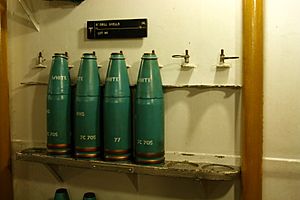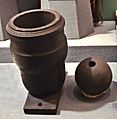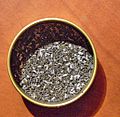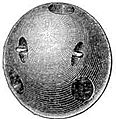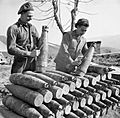Shell (projectile) facts for kids
A shell is a special type of projectile that gets shot out of big guns. Think of it like a very large bullet or a small bomb. Shells are usually filled with explosives, but they can also carry other things, like materials that cause fires. They are fired from powerful weapons such as artillery guns, tanks, and warships.
Most shells look like a cylinder that gets narrower at the front, ending in a point. However, some special shells might have different shapes for specific jobs. For example, anti-tank guns fire very strong shells with less explosive inside, designed to punch through thick armor.
Contents
How a Shell Works
A shell is more than just a metal casing; it's a complex piece of engineering designed to do a specific job when it hits its target.
The Fuze: The Shell's Brain
Every shell needs a way to explode or release its contents at the right moment. This is done by a device called a fuze. The fuze is like the shell's brain. It can be set to make the shell explode:
- When it hits something (impact fuze).
- After a certain amount of time (time fuze).
- When it gets close to a target (proximity fuze).
The fuze makes sure the shell does its job exactly when and where it's needed.
What's Inside a Shell?
Shells can carry many different things inside, depending on their purpose:
- High-Explosive Shells: These are the most common type. They are filled with powerful explosives like TNT. When they explode, they cause a lot of damage with a big blast and flying fragments.
- Anti-Armor Shells: These shells are designed to destroy armored targets like tanks. They often have a very hard, pointed tip and use their speed and weight to punch through armor. Some might have a small explosive charge to cause more damage after piercing.
- Illuminating Shells: Instead of explosives, these shells carry a bright flare and a small parachute. They are fired into the air and light up the battlefield at night, helping soldiers see.
- Smoke Shells: These shells release a cloud of smoke when they land. Smoke can be used to hide troop movements or to mark targets.
- Specialized Shells: There are also shells that can carry smaller bombs (called submunitions), or even highly advanced shells guided by GPS or lasers to hit targets with incredible accuracy.
Shells Through History
Shells have been used in warfare for hundreds of years, evolving with technology.
- Early Shells: The very first shells were simple hollow balls filled with gunpowder, lit by a slow-burning fuse. They were often fired from mortars or early cannons.
- Modern Shells: As guns became more powerful and accurate, shells also improved. The invention of smokeless powder in the late 1800s made shells much more effective, as it allowed guns to fire faster and further without creating huge clouds of smoke.
- World Wars: During the First World War and Second World War, shells became incredibly important. New types were developed, including shrapnel shells (which burst in the air to spray bullets) and high-explosive shells that could destroy fortifications.
- Today: Modern shells are incredibly advanced, with some even having their own guidance systems to hit targets with pinpoint accuracy, like the M982 Excalibur shell which uses GPS to guide itself.
Images for kids
-
Some sectioned shells from the First World War. From left to right: 90 mm shrapnel shell, 120 mm pig iron incendiary shell, 77/14 model – 75 mm high-explosive shell, model 16–75 mm shrapnel shell.
-
US scientists with a full-scale cut-away model of the W48 155 millimeter nuclear artillery shell, a very small tactical nuclear weapon with an explosive yield equivalent to 72 tons of TNT (0.072 kiloton). It could be fired from any standard 155 mm (6.1 inch) howitzer (e.g., the M114 or M198).
-
155 mm M107 projectiles. All have fuzes fitted.
-
The 'flying-cloud thunderclap-eruptor' cannon from the Huolongjing
-
A mortar with a hollowed shell from the Boshin war
-
The Armstrong gun was a pivotal development for modern artillery as the first practical rifled breech loader. Pictured, deployed by Japan during the Boshin war (1868–69).
-
Poudre B was the first practical smokeless powder
-
Sir James Dewar developed the cordite explosive in 1889
-
British gun crew preparing 155 mm shells at Vergato, Italy on 22 February 1945
-
15 inch high-explosive howitzer shells, circa 1917
-
QF 12-pounder common pointed shell
See also
 In Spanish: Obús (proyectil) para niños
In Spanish: Obús (proyectil) para niños


